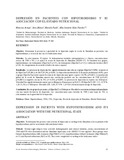| dc.rights.license | http://creativecommons.org/licenses/by-nc-sa/3.0/ve/ | es_VE |
| dc.contributor.author | Araujo, Maryory | |
| dc.contributor.author | Alonzo, Sara | |
| dc.contributor.author | Paoli, Mariela | |
| dc.contributor.author | Salas, Alba | |
| dc.date.accessioned | 2018-09-26T18:44:52Z | |
| dc.date.available | 2018-09-26T18:44:52Z | |
| dc.date.issued | 2018 | |
| dc.identifier.issn | 1690-3110 | |
| dc.identifier.uri | http://www.saber.ula.ve/handle/123456789/45233 | |
| dc.description.abstract | Objetivo: Determinar la presencia y gravedad de la depresión según la escala de Hamilton en pacientes con
hipotiroidismo, y su asociación con el estado nutricional.
Métodos: Se seleccionaron 78 sujetos. Se determinaron variables antropométricas y clínicas, concentraciones séricas de TSH y T4L y se aplicó la escala de depresión de Hamilton (HDRS-17). Se formaron tres grupos, hipotiroidismo con tratamiento (HipoConT; n=35), sin tratamiento (HipoSinT; n=15) y eufunción tiroidea (EuT; n=28). Se categorizaron de acuerdo al índice de masa corporal.
Resultados: La presencia de depresión fue significativamente más alta en el grupo HipoSinT (80%) respecto al de HipoConT (48,6%) y de EuT (39,3%; p<0,04). La depresión moderada fue la de mayor predominio (40%), pero el grupo HipoSinT presentó mayor frecuencia de depresión muy grave y grave (26,7%; p=0,002). La puntuación global de la escala de Hamilton mostró una correlación positiva con las concentraciones de TSH (r=0,407; p=0,0001) y negativa con las de T4L (r=-0,293; p=0,009). La presencia de depresión en sujetos con Sobrepeso-Obesidad fue significativamente mayor que en Bajopeso-Normo peso (p=0,012). El HipoSinT (OR: 5,71; IC 95%: 1,38-23,58) y el Sobrepeso-Obesidad (OR: 3,60; IC 95%: 1,34-9,64) tuvieron mayor riesgo de depresión.
Conclusión: En este grupo de pacientes, el HipoSinT y el Sobrepeso-Obesidad se asociaron en forma independiente con una mayor frecuencia de depresión. Las concentraciones más elevadas de TSH y más bajas de T4L se relacionaron con la gravedad de la depresión. | es_VE |
| dc.language.iso | es | es_VE |
| dc.publisher | Saber-ULA | es_VE |
| dc.rights | info:eu-repo/semantics/openAccess | es_VE |
| dc.subject | Hipotirodismo | es_VE |
| dc.subject | TSH y T4L | es_VE |
| dc.subject | Depresión | es_VE |
| dc.subject | Escala de depresión de Hamilton | es_VE |
| dc.subject | Estado Nutricional | es_VE |
| dc.title | Depresión en pacientes con hipotiroidismo y su asociación con el estado nutricional | es_VE |
| dc.title.alternative | Depression in patients with hypothyroidism and its association with the nutritional state | es_VE |
| dc.type | info:eu-repo/semantics/article | es_VE |
| dcterms.dateAccepted | Mayo 2018 | |
| dcterms.dateSubmitted | Febrero 2018 | |
| dc.description.abstract1 | Objective: To determine the presence and severity of depression according to the Hamilton scale in patients with hypothyroidism, and its association with nutritional status.
Methods: Seventy-eight subjects were selected. Anthropometric and clinical variables, serum concentrations of TSH and FT4 were determined and the Hamilton depression scale (HDRS-17) was applied. Three groups were formed, hypothyroidism with treatment (HipoWithT; n=35), hypothyroidism without treatment (HipoWithoutT; n=15) and thyroid eufunction (EuT; n=28). They were categorized according to the body mass index.
Results: The presence of depression was significantly higher in the HipoWithoutT group (80%) than in
HipoWithT (48.6%) and EuT (39.3%; p <0.04). Moderate depression was the most prevalent (40%), but the
HipoWithoutT group presented a greater frequency of very severe and severe depression (26.7%; p=0.002). The overall score of the Hamilton scale showed a positive correlation with TSH concentrations (r=0.407; p=0.0001) and negative with those of T4L (r= -0.293; p=0.009). The presence of depression in overweight-obese subjects was significantly higher than in normal-low weight (p=0.012). The HipoWithoutT (OR: 5.71; 95%CI: 1.38-23.58) and the overweight-obesity subjects (OR: 3.60; 95%CI: 1.34-9.64) had higher risk of depression.
Conclusion: In this group of patients, HipoWithoutT and overweight-obesity were associated independently with a higher frequency of depression. Higher concentrations of TSH and lower concentrations of FT4 were related to the severity of depression. | es_VE |
| dc.description.colacion | 97-108 | es_VE |
| dc.description.email | paolimariela@hotmail.com | es_VE |
| dc.description.email | albapa1@hotmail.com | es_VE |
| dc.description.frecuencia | Cuatrimestral | es_VE |
| dc.identifier.edepositolegal | ppi200902ME4351 | es_VE |
| dc.publisher.pais | Venezuela | es_VE |
| dc.subject.dependencia | Sociedad Venezolana de Endocrinología y Metabolismo | es_VE |
| dc.subject.facultad | Facultad de Medicina | es_VE |
| dc.subject.institucion | Universidad de Los Andes | es_VE |
| dc.subject.keywords | Hypothyroidism | es_VE |
| dc.subject.keywords | TSH and T4L concentrations | es_VE |
| dc.subject.keywords | Depression | es_VE |
| dc.subject.keywords | Hamilton Depression Scale | es_VE |
| dc.subject.keywords | overweight- obesity | es_VE |
| dc.subject.publicacionelectronica | Revista Venezolana de Endocrinología y Metabolismo | |
| dc.subject.seccion | Revista Venezolana de Endocrinología y Metabolismo: Articulos | es_VE |
| dc.subject.thematiccategory | Medicina y Salud | es_VE |
| dc.subject.tipo | Revistas | es_VE |
| dc.type.media | Texto | es_VE |


